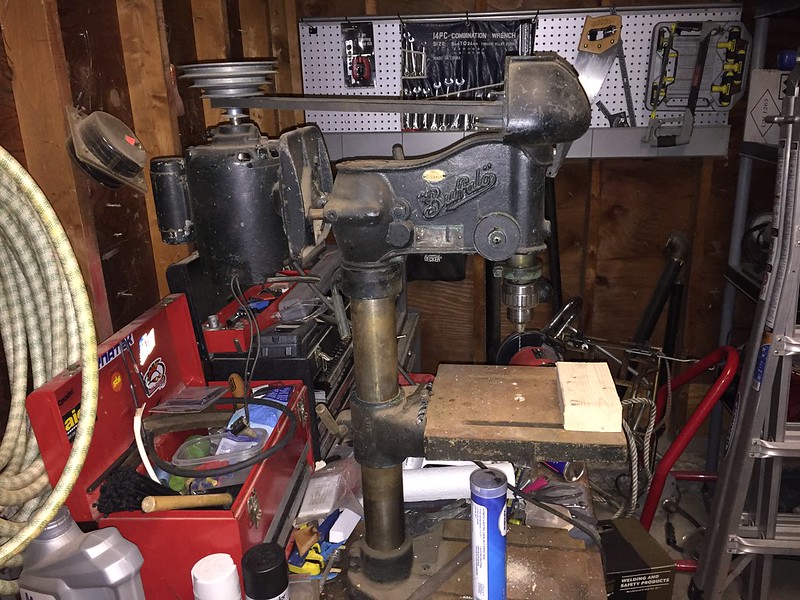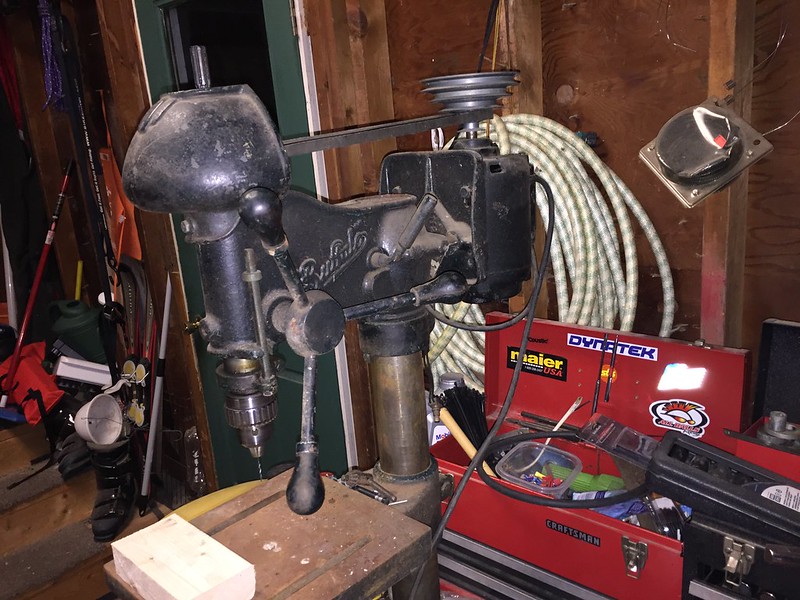Hello all,
I have just been given an old Buffalo #15 bench style drill press. I would like to clean it up and restore it a bit and was wondering if you all could help by pointing me in some good directions for information.
The Good:
- It runs great!
- The table slides up and down and side to side pretty easily.
- The drill assembly itself can slide up and down pretty easily on the vertical shaft.
- No cracks in any of the housings that I have found.
- All three handles have the original wooden knobs.
The Bad:
- It's been repainted at least once
- There is a push button power switch that has been "installed" but is just dangling off the motor.
As you can tell from the good vs. bad list, I feel I got a pretty good deal for a free drill (Granted, it was my Dad who gave it to me, but still).
The specifics that I am trying to find are this:
- Are there any ways to tell if this is an original motor?
I know that this is a long shot, but the motor is pretty old and has a capacitor on the back about the size of a small Redbull can. It does have regreasable bearings top and bottom, though, which is nice in a way
- Is there a manual or parts list anywhere online that I could download?
Obviously I'm looking for a scan of an original, but anything close would be nice.
And lastly:
- Would it be a bad plan to use a milling table on this machine?
My research has lead me to believe that this drill was made somewhere between 1937 and 1956. I don't want to do it any harm, but I do plan to use it and it would be nice if I could install a miller table for some projects.
What do you all think?
I have just been given an old Buffalo #15 bench style drill press. I would like to clean it up and restore it a bit and was wondering if you all could help by pointing me in some good directions for information.
The Good:
- It runs great!
- The table slides up and down and side to side pretty easily.
- The drill assembly itself can slide up and down pretty easily on the vertical shaft.
- No cracks in any of the housings that I have found.
- All three handles have the original wooden knobs.
The Bad:
- It's been repainted at least once
- There is a push button power switch that has been "installed" but is just dangling off the motor.
As you can tell from the good vs. bad list, I feel I got a pretty good deal for a free drill (Granted, it was my Dad who gave it to me, but still).
The specifics that I am trying to find are this:
- Are there any ways to tell if this is an original motor?
I know that this is a long shot, but the motor is pretty old and has a capacitor on the back about the size of a small Redbull can. It does have regreasable bearings top and bottom, though, which is nice in a way
- Is there a manual or parts list anywhere online that I could download?
Obviously I'm looking for a scan of an original, but anything close would be nice.
And lastly:
- Would it be a bad plan to use a milling table on this machine?
My research has lead me to believe that this drill was made somewhere between 1937 and 1956. I don't want to do it any harm, but I do plan to use it and it would be nice if I could install a miller table for some projects.
What do you all think?




 Your responses were kind of what I was wondering, but thought that maybe the good ole' fashion construction on this bugger might lend itself to being sturdier then the cheaper stuff out there today. No worries.
Your responses were kind of what I was wondering, but thought that maybe the good ole' fashion construction on this bugger might lend itself to being sturdier then the cheaper stuff out there today. No worries.  ), and the DP has been drilling nice and true for us.
), and the DP has been drilling nice and true for us.